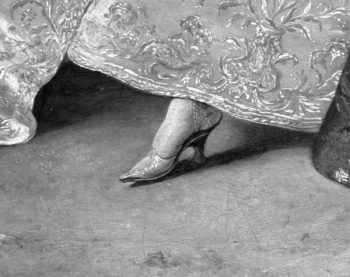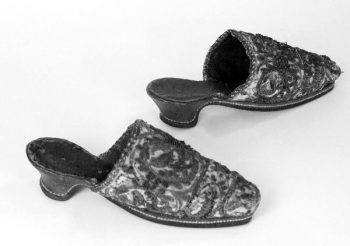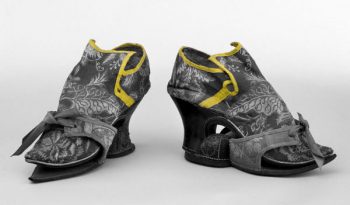Cinderella’s glass slippers and the power of words
Today’s discussion is going to be somewhat different than usual. I would like to talk about the importance of words in our lives, despite the fact that most of us don’t usually credit them with any importance at all.
Moreover, most of us don’t really consider all the words we use daily, and think using different ones is pure semantics.
Yet, I would like to show how a single word can shape the concepts and paradigms of whole people’s and countries, using one unusual and colorful example.
The familiar story I have chosen to focus on today is, as you have already guessed, the story of Cinderella.
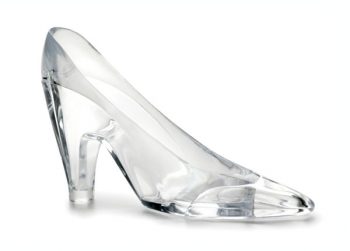
The central symbol
What is the first thing on your mind when you think “Cinderella”? There are many common answers to that: the rise from rock bottom to the top; a royal ball; impossible magic; the reward for humility… But if I ask you to conjure the central symbol most strongly associated with Cinderella’s story – there is but one answer: her glass slippers.
Few people think beyond the picture to its real significance. After all, this is only a children’s fairy tale, it’s filled to the brim with magic as it is, what would be the point to invest too much thought or look for logic in such a familiar concept?
Still, I wish to draw special attention to the image in your mind of the glass slippers.
My objective here is demonstrating the thinking outside the limits of what is acceptable, of the familiar and the comfortable, that which we do not question. Why? Because there are things in every process, every organization, every home we do “just because”, due to historical reasons, due to something no-one no longer remembers or wonders about anymore, “because that’s just how it’s done”. Things we assume all our lives to be true and self evident without doubting or questioning – because that’s what we’ve always been told, because we are programmed to accept the words at face value.
And what would happen if we challenged them?
In many cases we would discover surprising new truths capable of freeing us from the glass ceiling of our current thinking, or at least some limiting belief. In many cases this may lead us to a genuine breakthrough in our thought process.
So let’s demonstrate the process in the two words from the fairy tale: glass slippers.
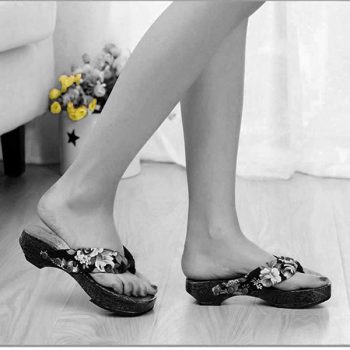
The material and the role
Think for a moment what that means. These are the glass slippers the fairy has given to Cinderella, supposedly to help her… hmm, yes, that’s right, dance at the Prince’s ball. Dance. In glass slippers. So that her grace and charm could win his heart, undoubtedly. Seriously? Does that make any sense?
Anyone who’s ever danced at a ball would know it makes no sense whatsoever, unless the fairy really wanted Cinderella to wreck her feet in the quickest possible way, for she would surely not impress him with her ensuing goose-like walk. That is, assuming the slippers do not shatter.
Glass is a rigid material, almost completely devoid of elasticity. Imagine even simply walking in shoes which do not respond at all to the changes in the foot during walking. Totally rigid shoes.
Some would reply that in Holland they used to wear wooden shoes, and this is true. However, first, only the people of lower classes wore them: you have never heard of or seen a painting of Dutch aristocracy wearing wooden shoes! Cinderella is high-born, or her family would never have received invitation to a ball, where a future queen is to be selected. We have other indicators as well for her noble birth. Second, even had the nobility worn wooden shoes, I’d venture the line would be drawn at ball dances. Just imagine the grace (and the noise, which would drown the music).
So where has this surprising notion originate?
Here comes some fascinating historical research into the story of Cinderella.
The story's history
It appears that the story, along its most general lines, has very long roots spreading all over the world. A similar story is known in ancient Greece, in China and other countries far and wide, and it is considered folklore. In 1893 Marian Roalfe Cox has published Cinderella: Three Hundred and Forty-Five Variants of Cinderella, Catskin and Cap o’Rushes, Abstracted and Tabulated with a Discussion of Medieval Analogues and Notes, commissioned by the Folklore Society of Britain. All versions vary in details, and the words “glass slippers” are mentioned only in one version.
Two of the latest and most familiar versions of this fairy tale are the one by the authors, linguists, cultural researchers Jacob and Wilhelm Grimm, who lived in Germany in 1785–1863; and the other by the author and member of the Académie française Charles Perrault, from France, 1628-1703. Both versions are parts of a life-project of collecting oral folklore fairy tales and documenting them in a single published volume. This job includes translating the stories into “modern” language, e.g. that used at the times of the authors, and sorting and arranging the various details into one single fullest version. I must add that both versions are a lot more interesting than the bland depiction presented by Walt Disney…
The only version where the words “glass slippers” make an appearance is the one written by Charles Perrault, published in 1697, which clearly indicates it is there we must search for the answers.
The original words
Precisely what has Charles Perrault written about the fairy’s gift? Well, he has named the story Cendrillon ou la Petite Pantoufle de verre, which translates to English exactly as “Cinderella and the little glass pantoble”.
Now we must answer two questions: what sort of shoe is the pantoble, or pantoufle, in France, and where has the choice of glass as their material come from.
What sort of shoe is the pantoufle?
According to the Oxford English Dictionary, the pantoufle (pantoufle in France; pantuflo in Spain; pantofle in Italy; pantoble in England) is: “A slipper; a loose shoe. In early use applied to any type of indoor shoe, especially applied to high-heeled cork-soled Spanish or Italian chopins.
In addition, the word also applied to outdoor overshoes or galoshes. In later use, a slipper, sandal, or light shoe of exotic or foreign (esp. oriental) style. From the late 15th to the mid 17th century, overshoes shaped like mules, called pantofles (pantables or pancakes), were worn to protect the front of the shoes.” (From Chopine, Zoccolo and Other Raised High Heel Construction website, dedicated to the research of footwear). The pantobles were usually made to match the inner shoe, and they were worn by both men and women.
Alright, now we have a second option for the shoes, and the choice of the pantobles’ material has just become even weirder: slip-on overshoes, worn over the shoes to protect them – made of glass?
The use of glass in the 17th century
Not to mention that glass in the 17th century was not only a very expensive material, a fact which could even have supported the choice and rendered the fairy’s gift more luxurious. But its manufacturing was unstable. No one in their right mind would have suggested using glass to make shoes in the 17th century, let alone slip-on overshoes, intended to protect the inner shoes! It simply defies reason, and say as you will, these people were pretty reasonable, that’s the whole point behind the fairy and magic.
The magic has served in order to get what has been, reasonably thinking, impossible to get, but everyone dreamed of: marry a prince, when the girl is, it seems, at rock bottom. A veritable servant. A class gap, no gown, no way of getting to the ball… and here comes the magical fairy God-mother to the rescue. But glass slippers? What’s the dream about that? Especially, when you recall that the dreaming was done by the low classes, they were the ones creating fairy-tales, not the court ladies. So even if we imagine that someone has come up with the idea of glass slippers (Charles Perrault was the only one who did) and not consider it completely preposterous, the upper classes would know that, and it’s not their story. The lower classes would think it simply ridiculous.
By the way, perhaps some of you may be asking:
Why did the inner shoes need protecting in the first place?
Well, in stark contradiction to the squeaky-clean, well-lit and glamorous look in the movies, the 17th century streets (and hundreds of years before and after) were, how shall I put it, unfit for walking in a ball gown and delicate pretty embroidered shoes, which, in fact, the lady could not even see under the wide skirts of her dress. Why unfit, you would ask?
Firstly, the main mean of transport was the horse, or something pulled by horses (a wagon, a carriage etc.). And the horse, shall we say, is not very hygiene conscious. When the need arises to unload waste from its bowels, it would just raise its tail and move it to the side and… there is a mine in the middle of the street. Now multiply it by many horses and carriages, add other animals…
Second, there was no concept of sewage. At best, there were narrow ditches alongside the road, into which the housewives, servants, kitchen help and such would empty their buckets and chamber pots. Otherwise – right into the street. From the open second-story window.
Finally, there was neither real street cleaning to speak of nor good lighting for the dark hours. Add in the mud and rain puddles…
Now imagine the fancied-up lady alighting from her lovely mud-splattered carriage in front of the palace entrance. The same place dozens of carriages stood in before her, where dozens if not hundreds of horses had a brief respite. She could raise her skirts somewhat from the ground, to keep from sweeping all this natural wealth with her dress, but that’s about it. What about her delicate shoes, then?
Now it should be clear why they needed protection, shouldn’t it?
Charles Perrault's context
Charles Perrault was, as stated earlier, French, who live in 1628-1703. Not only did he collect French fairy tales, but he veritably translated them into the French of his time. Being a wealthy Parisian of the bourgeois class, Charles Perrault has risen very high at Louis the 14th court. The people in his surroundings were of similar status. It is important to note, for then it would become apparent that the French fashion of the time, worn by the high classes, was not only familiar to him, but closely observed on a daily basis.
We have already covered the type of shoe, the pantoufle, in use at his time.
The material he wrote was definitely glass: verre. In ancient archaic French, the language the tales were told to him, there is a word sounding exactly the same, but spelled differently: vair, meaning squirrel fur. Squirrel fur lining was luxurious and expensive.
At that time, there was at court a lady by the name of Madamme Françoise Scarron d’Aubigné, a young and penniless widow. By recommendation from her patron Madame de Montespan, who was the king’s official favorite (mistress), she was placed to raise her children by the king. And why is she of interest to us in this story? Because this lady has in time become herself the official favorite and later the second wife of king Louis the 14th, and her story is very much following the typical Cinderella storyline. It is said the as the king’s unofficial wife she was nicknamed “the black queen” for her fanatic adherence to Catholic restrictions, her lack of tolerance to court entertainments. At that time the court of the Sun King has become dark and dull. It appears that she used to have pantobles lined with squirrel fur.
If that was the case, then we may conclude that the shoes Cinderella received from the fairy were:
- fashionable dancing shoes of her time;
- luxurious and especially comfortable and warm due to the squirrel fur lining;
- probably with slip-on overshoes, intended for protecting her dancing shoes until she entered the ball.
That should alter somewhat the image in your mind, shouldn’t it?
The choice of the glass for the story
It is highly unlikely that Charles Perrault would be unaware of all this. Although a possibility exists that he has missed the homonyms verre and vair, and made a simple and understandable mistake, – it is rather a remote one. It is far more likely that he has known the word used was vair, squirrel fur, and not verre, glass. Naturally, he also knew exactly what a pantoufle was. So why then has he chosen the other word?
It could be that he did not want anything to point to the “black queen”, for that could prove rather unpleasant.
One should also keep in mind that Perrault did not only collect the stories, but he beautified them. That is to say he cleaned them from everything that could be “in bad taste”, romanticized and made them more beautiful, sterile and Utopian than they originally were. For example, the sisters manage to wrestle their feet into the slipper by means of tricks, and not severe mutilations, which are openly described in the Grimm brothers’ version. He also widely used symbolism, and in this matter it appears to be the main reason for the change of image.
The shoe becomes a symbol for this pure-hearted girl, who manages to keep purity and innocence in spite of constantly doing the dirtiest work in the dirtiest place in the house, and do it pleasantly despite the nastiness of her family. He was searching for a material capable to carry this symbolism on its own, and what could be more pure than clear sparkling glass? In addition to its own purity, it is also easy to clean of any dirt, and thus a glass slipper would not even need a slip-on overshoe to protect it!
Thus have the luxurious slip-ons lined with squirrel fur become glass dancing slippers.
Cinderella's name
Incidentally, as long as we are discussing words in this story, some would think that Cinderella is the beloved girl’s name. This is not so. It is enough to see that in every language she goes by a different name, to understand this is not a name at all, but a nickname, based on the work she does and her condition: her hands, face and clothes are dirty with cinder, ash from the burnt wood in the fireplace, and which she scrubs from kitchen utensils.
In English her name is Cinderela, meaning the little-one of the cinders. The same meaning goes: in French – Cendrillon or Cendreusette; in Italian – Cenerentola; in Serbian – Pepeluga; in Russian – Zolushka; in German – Aschenpiittel or Aschenbrodel; in Finnish – Tuhkimo; in Lithuanian – Pеlenus; in Spanish – Ventafochs.
The other possibility for the nickname is just “the dirty girl”: in Hebrew – Lichluchit; in Russian – Zamarashka;…
The power of words
Well, what have we learned from this short historic research of Cinderella’s glass slippers?
We have seen that words have great power to shape concepts in our minds. All over the world it is enough to show a picture of a glass slipper and everyone would automatically make the connection to Cinderella, a connection which only appears in a single version out of at least hundreds if not thousands of versions for this folk story.
We have seen that few people pause to think: why is the slipper made of glass and how is that possible? Even fewer continue to search the answer to that question. Most just accept the words as they are.
We have seen a way to ask all the questions: what was the word used? what is its meaning? what kind of shoes fit that meaning? what is their role and what are they made of? was there an alternative word which might have been intended, had a mistake been made? was there, indeed, a mistake? why has the author not used the original word? what could have been his intention by using this specific word?..
Quite a few questions, and the process of searching for the answers could be fascinating research, which can change your whole perception of something you are so used to that you don’t even ask the question: is that true?
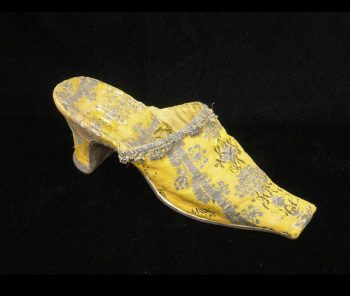
So let me ask you: do you think it might be worth your while to be a bit more aware of the assumptions we make, the truths we accept, and ask more “why is that so?” in places where “just because” are the typical answers? Do you think you might benefit from freeing yourself of being chained to some truths from the past?
If so – be aware of the words, and start questioning! For the benefit of freeing your mind may change your thinking in amazing ways and bring real break-through!
Pictures, top to bottom:
Declaration of love, by Jean François de Troy, 1731. Image from Brandenburg museum website.
Mules from the first quarter of the 17th century, Bata Shoe Museum, Toronto, Ontario. Image from Chopine, Zoccolo and Other Raised High Heel Construction website.
Women’s mules or backless slippers, ca. 1650s-1660s, England. Image from the Victoria and Albert’s museum.
The embarrassment of Paris. The Pont-Neuf seen from the side of Dauphine Street, Nicolas Guérard (1715). Image from an article on the filth of Paris at the UnDark website.
Madame de Montespan with her children, painting by Pierre Mignard, ca. 1677. Image from Wikipedia commons.
Shoes with pattens, 1690–1710. Leather, silk and linen. Collection of Shelburne Museum. Image from JeannePompafour Tumblr post.
Cinderella sitting in the fireplace. Illustration by Edmund Dulac for ‘The Sleeping Beauty and Other Fairy Tales’. Published 1910 by Hodder & Stoughton.
Woman’s Mule or Slipper, ca. 1660; England; silk brocaded with silver metallic threads, silver gilt lace trim, wood, leather, silk lining. Image from the Colonial Williamsburg Foundation website.
This post is available also in:
 עברית
עברית









